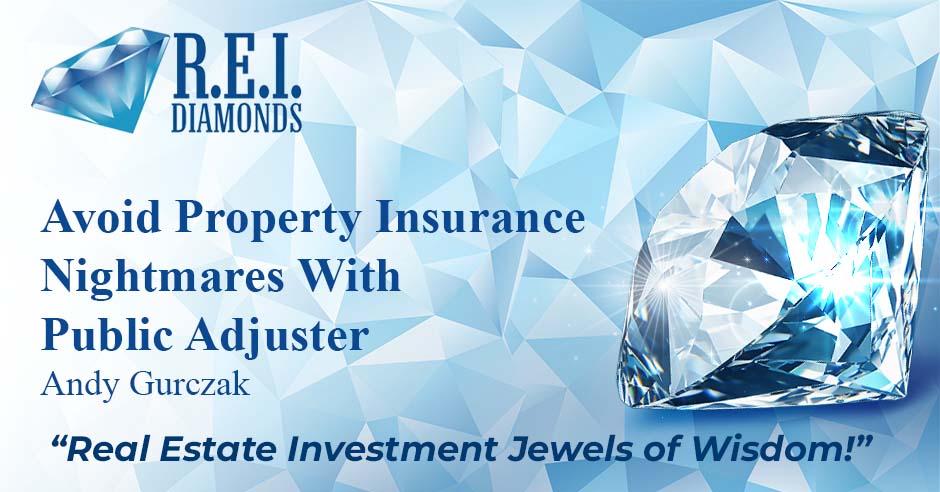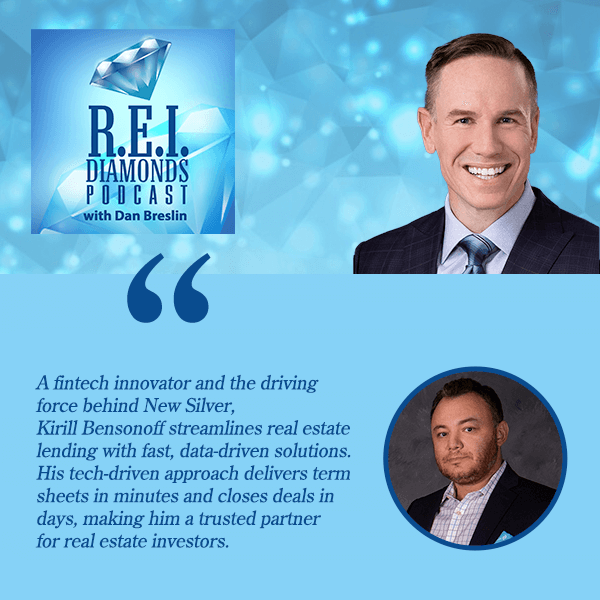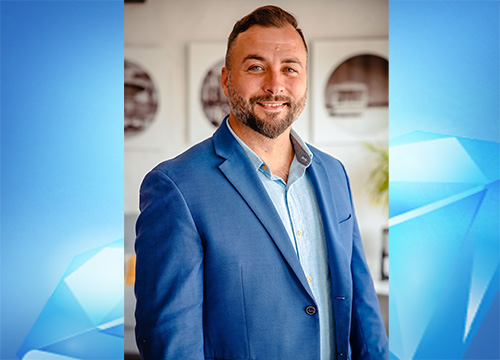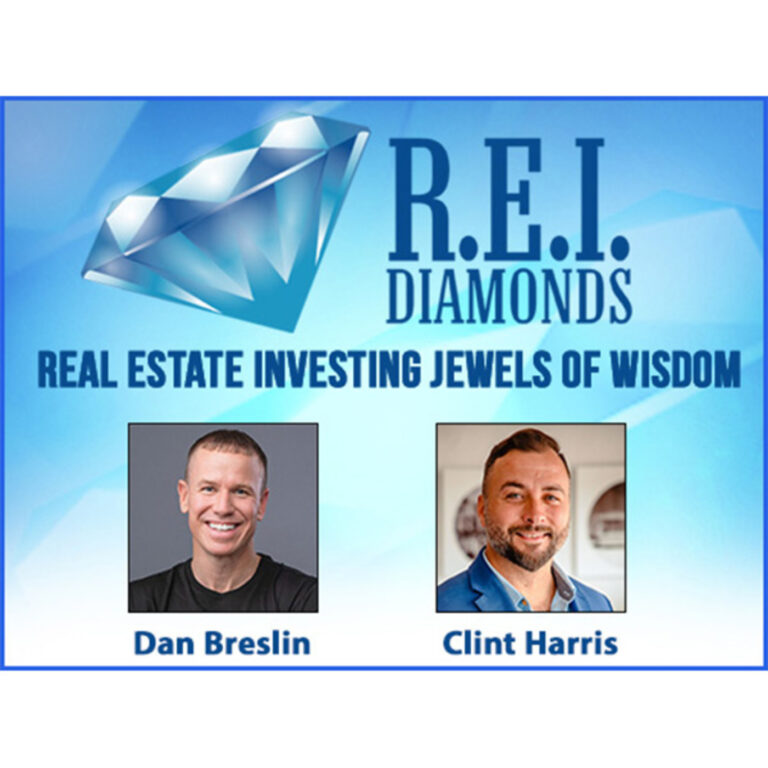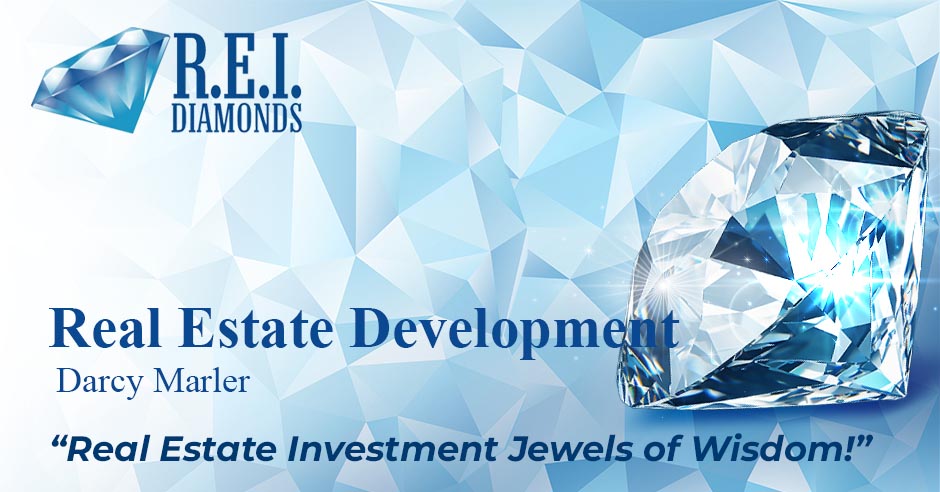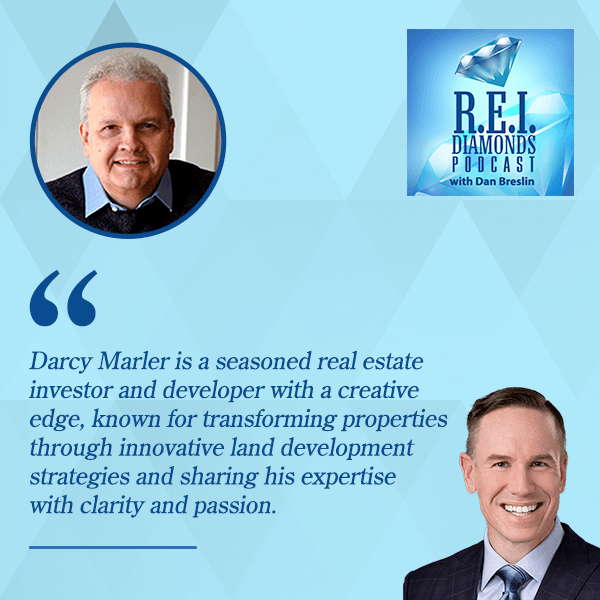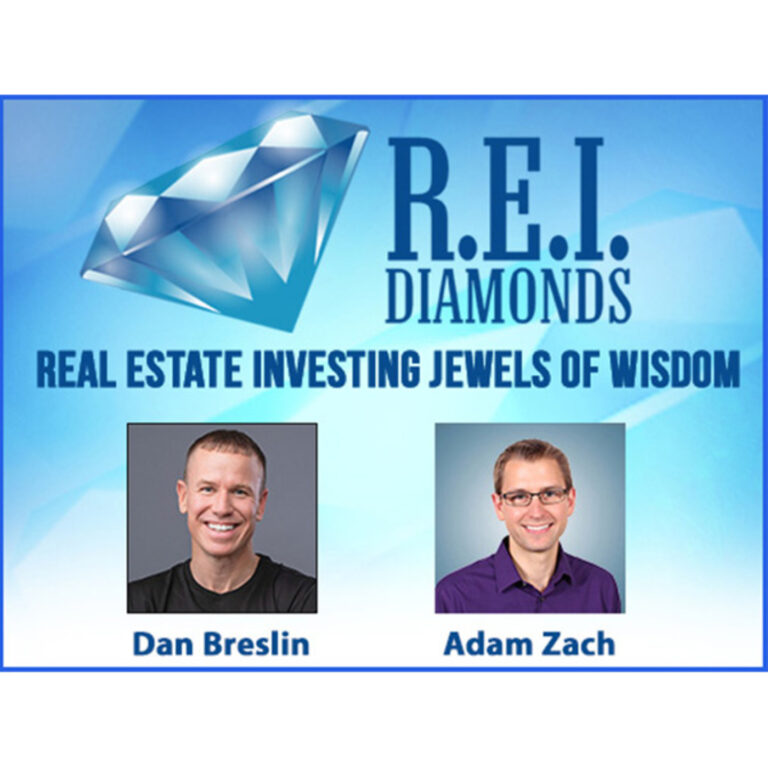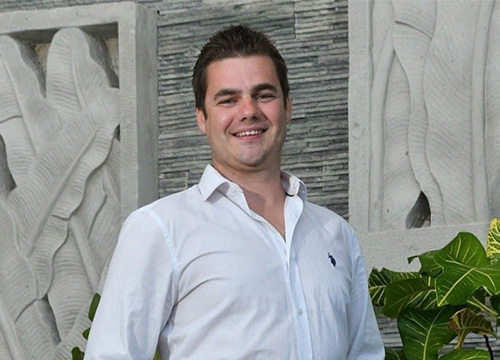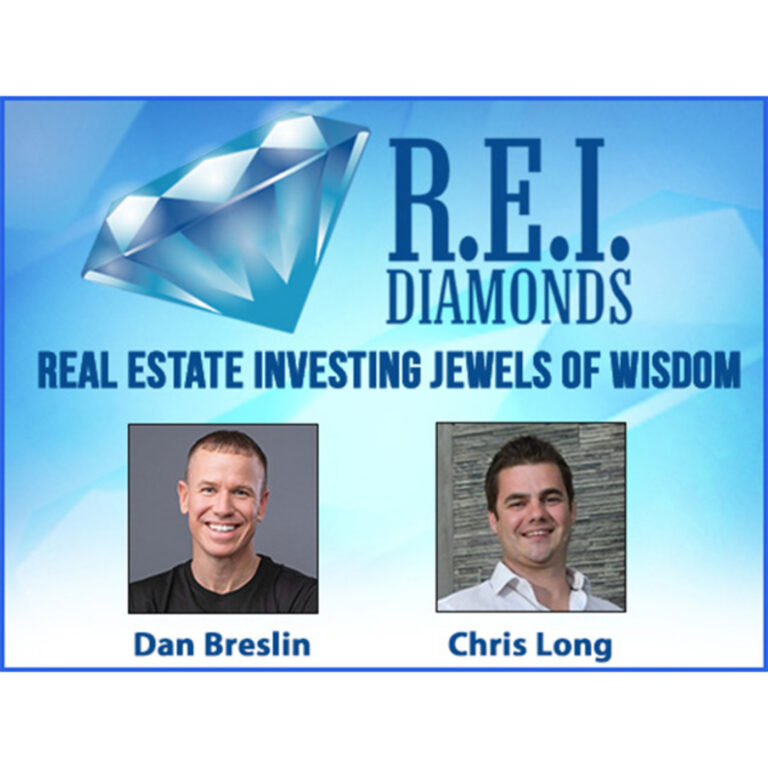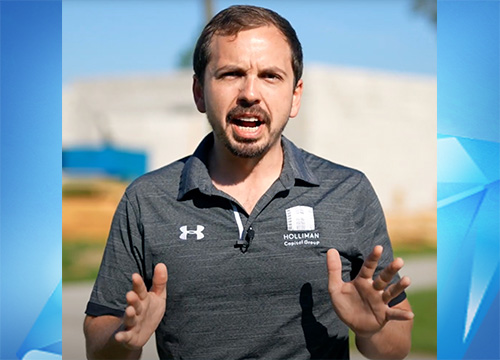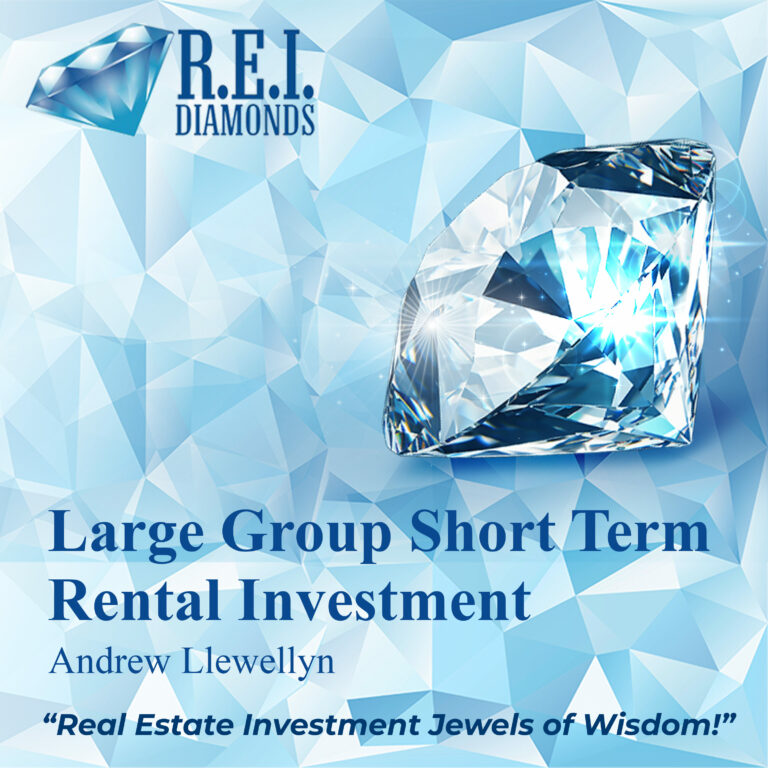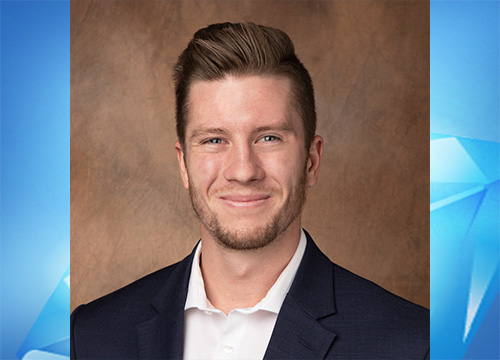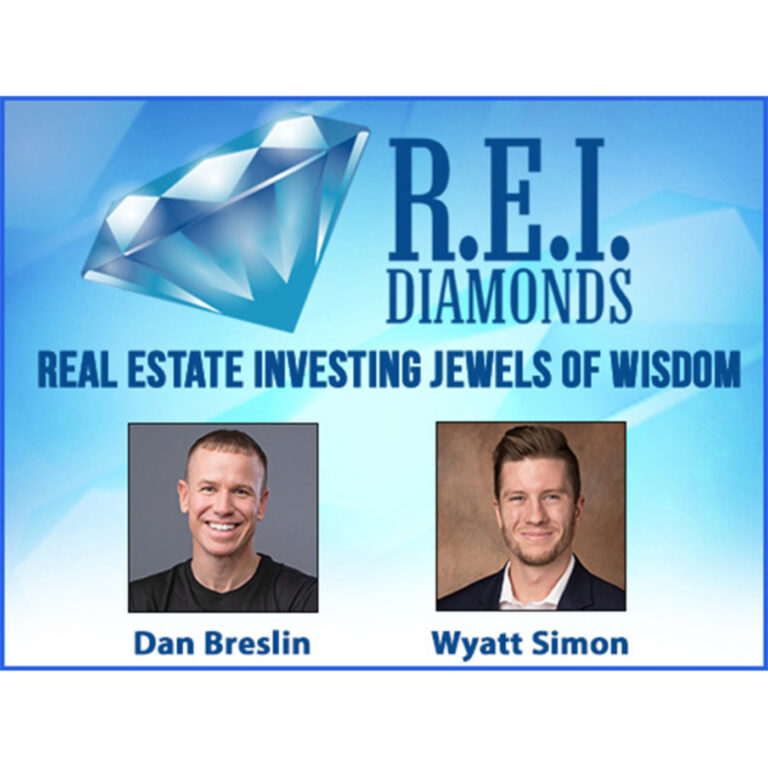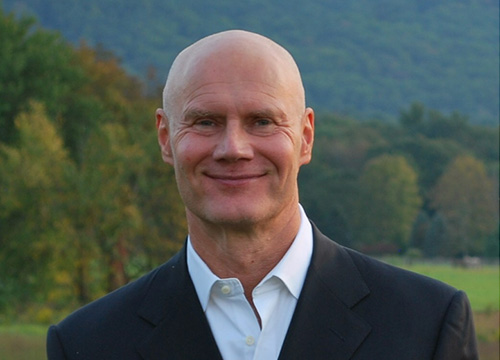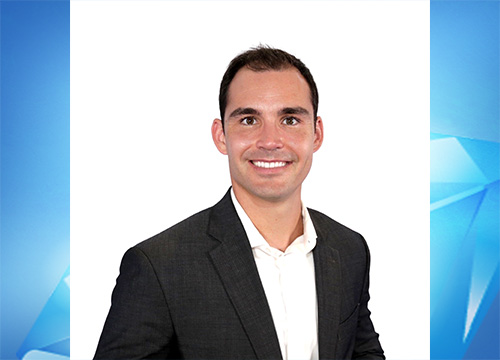Guest: Andy Gurczak is a seasoned real estate investor and public insurance adjuster. Starting with a humble duplex, Andy has strategically expanded his portfolio to include a variety of commercial properties. He leverages his construction background and keen market insight to navigate the complexities of real estate and insurance claims, making him a valuable resource for both novice and experienced investors.
Big Idea: Andy Gurczak delves into the intricacies of insurance claims for property investors, emphasizing the importance of strategic decision-making and a thorough understanding of the process to avoid pitfalls. He also shares his journey from residential to commercial real estate investing, highlighting the lessons learned and strategies for success in the commercial sector.
This episode of The REI Diamonds Show is sponsored by the Deal Machine. This software enables real estate investors to develop a reliable & low-cost source of off-market deals. For a limited time, you get free access here.
This episode is also sponsored by Lending Home. Lending Home offers reliable & low-cost fix & flip loans with interest rates as low as 9.25%. Buy & hold loans offered even lower. Get a FREE iPad when you close your first deal by registering here now.
Resources mentioned in this episode:
Andy Gurczak & I Discuss Avoiding Property Insurance Nightmares with Public Adjuster:
- 5:50 – Details of a 1031 Exchange: Insights into executing a 1031 exchange successfully and the lessons learned from the process.
- 10:01 – Acquiring a Seven-Unit Commercial Property: The story behind acquiring a prime commercial building and its financial implications.
- 15:40 – Financing Strategies: How leveraging relationships with local banks facilitated property acquisitions.
- 18:30 – Property Management and Tenant Relations: Managing properties personally and dealing with tenant issues directly.
- 27:35 – Critical Timing in Claim Filing: Brother Elijah’s experience highlights the importance of acting swiftly and seeking expert advice to maximize claim value.
- 29:19 – Settlement Offers and Pitfalls: Andy shares insights into deciphering settlement offers and avoiding potential traps.
- 35:52 – Commercial vs. Residential Claims: Understanding the dynamics between commercial and residential claims can influence strategy and approach.
Relevant Episodes: (200+ Content-Packed Interviews in Total)
- Andy Shamberg on Property Insurance Fundamentals
- REI Diamonds Show with Rick Thompson on Building Green, High-Performance New Construction
- 100+ Unit Apartment Syndication with Stephanie Walter
- Rental Property Insurance Pitfalls with Attorney Galen Hair
- How to Avoid Capital Gains Tax Using a Deferred Sales Trust or Like Kind Exchange with Carl Worden
—
Watch the episode here
Listen to the podcast here
Avoid Property Insurance Nightmares With Public Adjuster Andy Gurczak
Andy Gurczak, welcome to the show. How you doing?
Dan, thank you so much for having me on. It’s a pleasure.
Yeah, for sure. We’ve been trying to link up here for a little while to get you on the show. Main topic’s going to be insurance claims, and I think it’s valuable for the readers to hang in there, whether they’re single-family investors, whether they’re commercial investors, nobody wants to have an insurance claim ever, but when you do, you can really, in my experience, get screwed up by doing it wrong or maybe even choosing to make the claim in some instances.
Andy Gurczak’s Investing Journey And Business Focus
I know that’s been my issue, claiming something too small, but we’ll get into all the problems and the solutions and what you do as an adjuster and why that’s something valuable here shortly. Before we do that, Andy, do you want to give us a background on maybe some of your investing career and then also how you got into and what your adjusting business is now?
Yeah, so when it comes to the investing, Dan, me and my wife bought our first duplex. This was when we got married. We bought our first duplex. We lived on one side and rented the other side. We basically lived for free. We had a little bit of income, even left over. I was able to scale the business, not pull any money, didn’t need to even make money at that point. I was able to reinvest everything. My wife worked where it brought enough for groceries into small stuff. That was under FHA. I think we bought that actually before we got married. Right before we got married, I think we bought that under my name. Two years later, we ended up buying another FHA under her name.
It was another duplex, so we ended up doing only 3.5% down, which was nice. It was a small investment out of our pocket to have two properties that were cashflowing really nice. From then, we bought a townhouse that was a foreclosure. We ended up buying a building that’s in downtown Crown Point where we live that we converted into a commercial. There are three tenants in there, actually.
In 2023, we did our first 1031 where we sold one of the duplexes, took the money and then bought a seven-unit building. It’s a commercial building. There are seven suites, about 15,000 square feet. I think that’s it. I know we have a lot. We’re building a home right now. Real estate has been something that we’re always interested in. We’re always looking to buy something different.
Before we get into the insurance topic, could we pull on the thread of the commercial deals? I think a lot of the readers, including myself, you flip, you start out maybe wholesale a couple of houses, flip a couple, do the house hack, like you did. I know there’s a lot of investors who will start by flipping houses, holding a few rentals. We all have this pool toward commercial real estate.
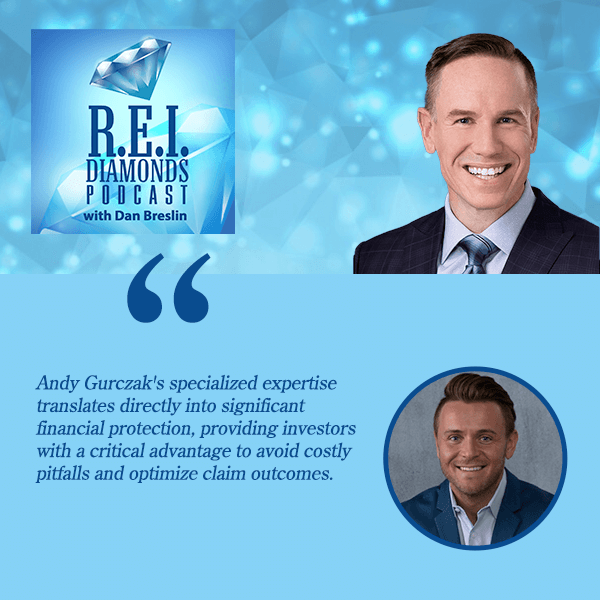
“I’m going to do commercial real estate someday. I want to get into commercial real estate someday.” That’s where I’m at. Over the last few years, I bought into a shopping center. We’re developing fourteen self-storage buildings. I have a 30,000 square foot warehouse that we’re just going to flip that one here coming up shortly. It’s been cool. It’s been a cool transition for me in the last couple of years. It is exciting to be able to put a little more capital to work when later in your career you have more capital to put to work. Would you mind touching on that first Crown Point commercial deal, maybe the purchase price, what your plan was?
Just so you know, all the properties we have were commercial. It happens because of the business. The business grew, so we needed more space. As a business grew, we’re like, “Let’s look.” The landlord actually that I was in renting from at that time, I always asked him. I knew he was a big developer. I said, “Do you know a lot of people in this area? If you were ever to sell anything or have something else, please let me know.”
It turns out he had a deal. The grandma, I don’t know if she passed away or something happened. The kids knew my landlord since he was little so they offered the house to him. He called me and said, “I don’t want this. We’re focusing on different stuff now. Would you want to take this off me?” I met him and I knew it’s in a perfect location. Location is everything. The price he gave us was so good. We could have probably turned around and doubled it right away. We took the first floor. We cut it in half. We did two offices. I took the back office, my business, we rented the front. The upstairs is a just a residential tenant.
That one made sense. It was cheap. You could have sold it for more immediately. There’s probably no hesitation there.
No. That one I knew right away. We bought that for I think $220,000. That one’s probably worth around $500,000, $600,000 at this point. The location is perfect.
Navigating A 1031 Exchange In Real Estate
Now you have the seven unit and the 1031 exchange. I think the 1031 exchange, I did one. I don’t know of a whole lot of interest in doing anymore. I probably would try them, but I remember the pressure and the stars having to align to make that deal work for me when I did it. It’s a great tool. I think it’s good. I think there’s a lot of readers who are like, “Yeah, I would like to do that someday too.” Would you mind walking us through the 1031 deal, Andy?
Same thing with this building. Our business has grown. We had more people, we needed a bigger space. We were looking to rent because there was nothing on the market. Everything’s pretty expensive. We found the building and there was a unit available. I contacted the realtor. We looked at it. I’m like, “That’s too big for what we need.” I explained to him that we’re always looking to buy. He said, “The owner is getting older. He is actually looking to sell.” I said, “Ask him how much he liked.” He came down with the price, which was really good. We bought it. I’m like, “Okay, we’re buying it.” I told my wife, “Let’s see if we could do a 1031.”
We ended up listing our duplex that we had another one and got offers on that right away. The 1031 process for us was super easy because we had the property already identified. For us, tactically it was different. Most people do no sell, then they have to identify the property within, what is it, 60 or 90 days? Whereas we already had the property. We knew a could sell really quick. To us, it was a no brainer. Everything made sense. The only mistake we made then that I wasn’t aware of, that property we had, the duplex was in mine and my wife’s name. When we bought this commercial, we wanted to buy that under our new LLC. When you do a 1031, you have to name it.
If you’re selling them your names, then you have to buy the property, the new one, in the same way you’ve sold the other one. If I knew that, I would’ve had retitled that duplex under the new LLC so then the closing, it would’ve been easy because then you’re selling as an LLC and you’re going into LLC, the same name. You can’t switch names. It follows the person that sells the building. If that makes sense, meaning if for anyone that ever does a 1031, make sure whatever you’re selling, that’s where you’re going to have the new building titled at, whether it’s your name or a different LLC.
Nice pro tip. How many square feet is this seven-unit commercial building?
15,000 square feet.
Nice size. One of the cool things I have to underline for the readers, because it’s just such a powerful way to find commercial property, is you stumbled upon this one, it sounds like. You call the agent for the vacant unit. There’s a lot of buildings out there with a similar type of circumstance where someone’s like, “I could just keep renting it. I could sell it. I’m not really trying to put it on the market.”
You have that perfect timing with a low amount of competition in the event that you overturned that stone, which you did hear on calling on the vacant unit and now it just so happens to be for sale. That’s like one of the expert strategies. I know quite a few people who have done that successfully and found phenomenal deals here, just like you did.
They always say there’s no good or bad. There’s no perfect market. Even now, people are like, “There’s no deals.” There’s deals. If I was 100% in real estate, I would be calling. I would find all our deals. Even the duplexes, we found those on our own with my wife. We didn’t even call an agent. By the time the agent told us this property’s for sale, we’re like, “Yeah, we’ve already told another agent. We’re already under contract.” Agents are just so slow sometimes. We find our own properties. The townhouse we bought that was foreclosure. We contacted the agent. By the time he contacted the seller, it was under contract. We’re like, “He was so slow about it.”
There’s no perfect market, but there are always deals. You just have to look and find them yourself.
A couple of weeks later, we’re looking online and the property’s back on the market. We called a different agent and made an offer. That guy, we were literally under closing, he calls. He’s like, “Huys, this property’s back on the market.” I’m like, “Yeah.” There’s always deals. You just have to look and find it yourself. The way we did this one, even speaking with that other developer, again, if you just talk to people and you get in networks you’ll find deals. There are deals out there.
Acquiring A Seven-Unit Commercial Property
What was the current net operating income on that when you bought it? Did you know that number and what was the purchase price?
The purchase price of the new building was $860,000. We bought it at $860,000. I want to say around $12,000 gross was what it was bringing in per month or more. Right now, it’s grossing around $15,000 something with me obviously not paying that much because I’m taking one of the main suites.
What are you paying in taxes?
We’re netting about $10,000 a month.
Okay. You’re at about $120,000. Even at an 8.5% cap, that’s got to put you at what?
I never do cap numbers. I don’t make real estate confusing, I make it very simple. What is our monthly expenses, our mortgage, our taxes, what is the income, what’s left over? I know what I still have to have for, if anything breaks. I know I can look at a building and know what needs to be remodeled or updated in the next years. To us, the numbers made so much sense. After all our expenses, snowplow and grass cutting in the summer, everything else you are left with a little bit over $10,000 a month.
You have space in there. I guess you’re paying yourself a little bit in a sense from the business.
It should probably be another $2,000, $3,000 netting in there if I was to pay the regular. Remember, the duplex we sold, we netted around $200,000. We took $200,000. Basically, the whole down payment was from that duplex. That duplex doubled in value. We took all that money put into this one. Technically, we only finance like $600,000
This thing would appraise no problem right now at like $1.4 million. I don’t know how anxious the banks are when there’s an owner occupant with the space. There are rules sometimes of certain percentage the owner occupies. They may treat it like owner occupied versus certain percentage is tenant-based. You have more investment value. $1.4 million, even at like 65% loan to value, which you could probably geta cash out refi and something like that would be around like $900,000. It would make complete sense to do that deal if you weren’t even going into that deal. You bought it for $860,000, you got it tenant in and then you pulled your cash back out. Did you guys have to put se serious capital improvements at all?
Nothing. I was in construction so I could inspect the building. I had to do my own inspections. I inspect my own buildings. No, I looked at this building, I knew that there’s seven air handlers on the rooftop units. I knew three of them are old. I knew that it was a matter of time and I could budget $7,000 or $10,000 grand for each one that’s going to break. One did go out. One of my employees, her husband actually owns a HVAC company. He got the unit for me for half the price. Had a friend put it in. I saved like half the month. I knew that was going to go out. Everything else, the building is all brick. Everything is fine. No maintenance.
It’s a smoking deal and I really appreciate you being candid here on the show about it because I think it’s a great. If someone’s flipping houses and they’ve got 10, 20 rentals, 40 rentals, a deal like this would be a great stepping stone into the commercial arena versus like buying a 100,000 square foot shopping center. I don’t know, I think you’d better off maybe learning on the $860,000 purchase.
I wouldn’t be ready to go into a shopping center. This was our first, and then that other commercial property that we turned right into a commercial, our little commercial on the square that we call it on a little downtown area. We took that single home, took it into the two offices and the tenant upstairs. We don’t really consider this commercial. This is really a true commercial unit, a true commercial building. I always told my wife like, “If we’re going to try it, let’s try it.”
We went from netting around $1,000 a month to taking the money from that property into this one and netting over $10,000. We’re going to lose a tenant right now that we were aware we’re going to lose. We’re going to lose about maybe 25% of income because they’re moving out. However, because this area is by the hospital and it’s a really good area, even if it takes longer, we’re fine. We could lose half our tenants and we’d still be even. All that stuff, we take into account. When it comes to numbers and cap numbers, to me, I always protect. If we lose half the tenants or if we lose how much do we have, how much do we have left over everything, worst case scenario?
Structuring Financing For Real Estate Deals
Yeah, and I like it. It’s a building that’s yours. There are not investors. A lot of people who are doing commercial deals are like raising the money from 10, 15 different people. There’s something to be said for owning the asset 100% with the wife, whatever the case is. There’s something to be said for that control long-term, especially to mitigate the risk of like, rent increases in space that your company might need. There’s a ton of reasons why this deal would make sense. How did you put the financing together? Was it like a local bank and you have to refinance?
Yeah, let me tell you. This was super great. I don’t know how much can I indulge into this, but we’re building a house. We’re building a house not far from here. We had a lot and because I’m GC-ing it myself, it was very hard to find a loan because not many banks want a loan to someone that’s GC-ing a project themselves.
There’s a local bank here that’s got two branches and they’re great. They ended up loaning the entire project, the entire build with me GC-ing. It turns out then my neighbors actually know the president of the bank. He’s also the underwriter. It turns out he’s great. He loves small businesses. As soon as we had this property, we found out. I contacted them.
I said, “We have this property. Would you guys want to look at it?” He was like, “Yeah, send me the numbers.” Next day, he was like, “Yeah, this is great.” That’s it. In a month, we were closed. That’s how it should be. It was working with them even for this construction loan now for anything. Now I’m like, “I will never go to another bank. They will get all my money. I will do every deal with them because it’s the most simplest process.” It was great. In my business, we banked with the Chases, like all the big branches and the servers just don’t care, I guess, unless you’re doing millions with them. You had to go through like ten people to just get an answer on some of the simplest stuff.
Understanding Market Rent And Price Per Square Foot
I feel like it must be hundreds of millions you have to do with them to get their attention. They’re trying a little bit, but their hands are always tied at the local level. There’s only so much they can do. Those local banks are fantastic. Do you know what your price per square foot is for the rent on any of the tenants? What’s your market rent?
I’m not sure. My wife has all the numbers in terms of square foot and what we’re renting each unit for. I know where they were rented for like fair amount compared to everyone else because she did the math when we compared it to other one. She would have those numbers. She runs more of the numbers. She collects the rents. Of course she collects the rent. She does the leases. I handle all the problems. The worst part is I’m in this building with the other six tenants. When there’s an issue, they just come and knock on my window.
It’s the only drawback.
My original plan was don’t tell anyone that I’m the landlord, but I like talk to people. As soon as we moved in, I’m the new landlord. All of a sudden, now I got people knocking on my window. We might have someone knock while we’re sitting here.
You must have all kinds of problems then.
Not many. Honestly, the only issues we’ve had besides the AC is the lights going out, the light bulbs. Now we’ve been converting them to LED. As soon as we have an issue, we have a method to convert them to LED and then we call it a day.
It’s a good deal. $57 a square foot on the purchase. I’m throwing a dart, but if I had to guess, probably like $8 to $11 a foot, something like that as the rent. I can see why the president was like, “Yeah, this one makes sense,” because when you do it on the cap rate and the investor math, it’s a good deal. Congrats on that find.
The agent asked us like, “What would you want to pay?” I said, “No. What does he want? I want him to make us an offer.” I think he said $890,000, and then we came down and we met at $860,000. The city appraised it for $1.1 million.
Was that just for taxes?
Yeah, and the city’s appraised low always. We knew if the city’s appraising it $1.1 million, we’re getting it. The math just made sense.
The Role Of An Insurance Adjuster In Real Estate
Let’s switch gears and dive into the insurance adjuster. What is an insurance adjuster and why should a real estate investor care?
There’s different adjusters. There’s a staff adjuster that works for the insurance company. You’re going to have the independent adjuster who works for the insurance company and then there are public adjusters. Sometimes they say private adjusters, but a public adjuster as known. The license it holds is an adjuster that works only for the insured. We can only represent the insured on their own claim.
When we explain to clients, it’s like, “The insurance company has their own adjusters, their own attorneys, their own contractors, their own team. Everyone works for the insurance company, so they’re all looking out on behalf of the insurance. They can’t they can’t be representing the insurance company and then coming out and looking on your behalf. It’s like an attorney representing two parties.” As a public adjuster, we represent the policy holder and advocate only for the policy holder.
Small little delineation there, but I’m just thinking back to when I first bought insurance, and I think I had a claim for a car accident when I was in my twenties. They came out and gave me a check. This is great. The adjuster just came right out. It was easy peasy. Through real estate, I’ve learned that they don’t necessarily pay out on every claim and they try to minimize the amount on certain claims. That would be the staff insurance adjuster or an independent adjuster working for the insurance company versus a public adjuster, which the insurance company’s not going to tell you that you should find or use a public adjuster, right?
That’s correct. They’re never going to tell you, you can hire a public adjuster. They’re not going to say hire an attorney. They’re going to keep pushing their own people, whether it’s, “We have our own vendor. Would you like to use our contractor? Would you like to use our own this?” They want to control the claim. We’re in this industry, so when I had an accident years ago and I got an estimate for my truck, we don’t work car claims, vehicle claims, but I remember going through the estimate line by line item, just like we do with buildings.
I remember there was $3,000 missing in that estimate because he had quoted lower parts that the truck actually had because it was like a better model. I was able to find $3,000, never worked in car loans. Just knowing the industry. If I was just a regular consumer, I would’ve got the check and be like, “Great. He cut me a check. This is all nice.”
What was the total amount of that claim? You found $3,000 extra in a claim.
It was $5,000 they gave me for my truck, and then I ended up finding another $3,000 there that they owed me. It was a $8,000 claim total.
We’re not talking an insignificant percentage of fine. That’s what the car insurance companies do. How much worse does it get in real estate?
We’re talking about huge numbers.
That’s right. Maybe we could talk about an example on a claim where they issued a certain amount of money and then you got involved and you found what, and then the total claim ended up being how much?
Yeah, the best one, we finished there’s probably a video with the insured. Brother Elijah, his claim, it was a church they purchased. They have a church, but they also do schooling. They were going to convert this old church into a school. They had a fire like a couple months after they purchased it. The adjuster came out and I think his initial estimate was like $800,000. That claim settled for like $3.1 million, I think, or $3.21 million.
It’s so significant, right? You could say, “Andy, that’s just your winners.” We’re always like, if we take a claim, we’re always going to significantly raise and get our clients every penny. That one’s a really big one. I’ll tell you, we had a sixteen-unit building that burnt down. He had a $550,000 policy and had a total loss. The adjuster came and wrote damages for like $580,000, but then he took depreciation. There’s a difference between ACB policy and ARCB policy. That insured only had an actual cash value policy, meaning that once the depreciation was taken away, that’s all he would get. He would not be able to claim the depreciation.
That adjuster gave him the $330,000 check. He actually called us because his investor-mentor recommended us. We looked at the building and I looked at the claim and I said, “You could tell that the adjuster start stopped writing his estimate because he got to like $580,000.” It was like right over the limit. When we got a hold of this job, the adjuster actually reached out to us and said, “Why is he hiring you guys?” I said, “What do you mean?” “I already paid him limits.”
I’m like, “We didn’t pay him limits. You wrote limits, but because the depreciation is so high, you’re only getting him $330,000. That’s all he could claim because he’s got an ACV policy only.” We ended up writing that estimate that damages were over $800,000. Even after you took out all the depreciation, he got a full settlement of $550,000 plus there was an endorsement for debris removal, so he had another $25,000 plus 5% of I forgot what other endorsement. He ended up getting an extra, I think, $300,000 that he wouldn’t have got.
Impressive. You breezed past ACV and ARCB.
Yeah, sorry, I didn’t want to stop right there. We just had an insured, same thing. They had a fire their investors out of Mexico actually, and their policy was an actual cash value policy too. A lot of people don’t know that. It’s scary. When the claim is settled, it’s always settled on a replacement cost value. When we calculate it, we’re going to say it’s going to cost $100,000 to replace this home. We’re going to say it’s twenty years old, all the material. Now we’re going to depreciate the material and, in some states, labor by 20%.
A lot of people don’t realize their insurance policy is actual cash value, not replacement cost. It makes a huge difference in a claim settlement.
If we’re going to take $100,000 depreciated by 20%, that’s $20,000. You take $20,000, that’s the depreciation, and now the insured gets the actual cash value, which is the $80,000, that’s your actual cash value, what’s left after the depreciation. Now if you have an actual cash value only policy, you are only getting that $80,000. Most policies are replacement cost value, meaning you get that depreciation amount once the repairs are complete.
The replacement cash value is the one that readers would want to make sure they bought.
A hundred percent. You always want a replacement cost policy.
Is that like the insurance broker should normally pick that up as they’re placing your policy, which brokers are shoving people into actual cash value policies?
I’m wondering the same thing because if I’m a broker and you come to me. I get a lot of the consumers maybe want to have the lowest premium. I don’t care. If I’m a good broker, I’m going to explain to you, “You’re going to save $1,000 or $2,000 a year, but understand that if you have a fire, you have a major disaster, you’re going to get half the money and that’s it.”
I don’t know how as an agent, you’re not explaining that well enough for the client to spend a little bit more or get them in it with a different carrier so they can actually be covered for the full amount. It’s a scary thing because if you know fires, again, no one ever thinks something’s going to happen to them. That’s the call we always get. “I always had insurance. I never thought this was going to happen to me.”
Everyone reading the show right now, that’s what we’re all thinking. “Nothing’s ever going to happen.”
I was on a podcast and the host, a really nice gentleman, and I won’t say his name, but a month after he reached out to me, he had a fire a month after we were on the podcast that he had me on. It never happened to him.
I’m assuming it worked out and you were able to perform?
Yeah. He was super happy. He was grateful.
Critical Timing In Claim Filing
Let’s go back to Brother Elijah’s deal. They offered $800,000, you got him $3.1 million. What a time period, and like what were the interactions? Maybe what we’re trying to pick out in this example, Andy, is could Brother Elijah have made a mistake by signing a document or cashing the check of $800,000 or something he could have done that would’ve like jeopardized the position? Do they have to call the adjuster within some certain timeframe? Where at in the process would you fit in there?
Yeah, Brother Elijah was very smart. They cut him the first check. I don’t know if he right away knew something was wrong. Actually, when we talked, he purchased the building for $700,000-something. When they told him it was $800,000, he thought it was pretty fair. When he got a contractor in there and the contractor told him, “There’s a lot of damage here. You might want to call, get a second opinion,” is when he reached out to us.
When I initially walked through that building, in my eyes, I’m like, “This is around $2 million and up.” Having a construction background, I know what it takes to put stuff back. I know the material price and labor price of stuff. In my head, right away, I could calculate everything. Even if he cashed the check, unless the check is a settlement, meaning it says settlement amount that you’re settling a claim with them, it doesn’t do anything. It’s an old myth. If they give you money, you take that money and you deposit as quickly as possible. Take that money, that’s your money. Whether you hire a public adjuster like us or you don’t, you want to take that money and keep fighting the claim.
Will they try to put a document in front of you at some point that says, “We’re accepting this as a full settlement,” or is there laws against that?
They wouldn’t put a document in. There’s claims we settled to where they say, “This is where we’re at. Would you guys want to accept the settlement offer at this?” The settlement offer says, “You guys are going to get a check and it says it’s a final settlement offer.”
That’s what you want to look out for then?
As long as the check doesn’t say settlement or you’ve signed something, but most checks that you get those first checks are those actual cash value checks. Brother Elijah, that $800,000, I think, his actual cash value was $400,000 like $500,000. That was his first check, the $500,000. If he was to deposit that check, it doesn’t hurt the claim or doesn’t do anything with the claim, that’s his money.
How Insurance Claims Are Paid Out Over Time
Does a normal insurance claim pay out 2, 3, 4 different checks? I’m curious, if I’m the insurance company and I want to operate in an unscrupulous fashion, why wouldn’t I have him sign off on the $500,000 when I’m sending the $500,000? It seems like they would attempt that, but they’re not attempting that all the time.
Most people won’t hire a PA. I think it’s said there are only 5% or 6% of insureds that actually hire a public adjuster or get help. They know most people won’t get help. They’re not going to look out to an attorney or reach out anywhere. They’re just going to they’re going to do their thing, they’re going to settle the claim, have a contractor go and do the repairs. Most of the time, when they want to hire a peer or want to hire someone, it’s too late.
Most people won’t hire a public adjuster. They’ll settle the claim, hire a contractor, and by the time they realize they need help, it’s too late.
Yeah. You have to get in there quick. Did Elijah hire you very early in the process? You may have just mentioned that
Very early. He got the offer and as soon as he got the offer, he had a contractor go in there and then a couple days after he contacted us. It was pretty early.
It sounds like one of the critical step steps is hiring the public adjuster immediately.
Yeah. If he hired us from the beginning, as we always recommend with most investors, like we’re Brother Elijah now, he had another fire actually at another building that he rents out to his parishioners for free. Actually, he doesn’t rent it out. If parishioners are going through a hard time, he lets them stay at this house. This guy’s great. This house actually caught on fire and so he called us right away. The best step is, again, even with that church, if he called us right away, it probably would’ve been more than $3.1 million. It probably would’ve been settled in half the time.
What was the timeline it took to settle that one?
Once we got hired, I think within 90 days, that was settled. That one was very quick. Depending on the claim, depending on the insurance company, depending on where we come in the claim process,
What would be the long end someone could expect. Let’s say single-family. We talked a little bit about commercial. Owner occupant, even. We run into this a lot. We buy these houses in Philadelphia, Chicago, around the country, and occasionally we’re getting the fire damaged. They’re calling because they had a fire a few months ago. One of the things the sellers are often mentioning to us, Andy, is, “We’re fighting with the insurance company. Let us settle this out, then we can deal with the sale.” I’m wondering if there might be a synergy there for us to introduce the adjuster or make sure they have the adjuster. I’m also curious, what’s that timeline for them on the long end to sort that out?
Yeah, with a fire, it should go pretty quick. Once we get hired on a fire, fire claims go pretty quick. That’s our specialty. Majority of our claims that we handle at all city is fires. We’ll do large water claims. We actually do in a couple tornado claims in Ohio. Large losses is our specialty. When it comes to a fire in like Chicago, those go pretty quick. If you have State Farm, again, I don’t want to shoot out one insurance company, but I just said it. With State Farm, they’re just so behind their adjusters that even if we give them our estimate and give them everything, it still takes like two months to go through like five managers just to issue a check.
You got to wonder if that’s because they’re behind or it’s a great strategy.
I’m going to tell you right now, this claim here in Ohio is a fire, it’s an investment group. There’s four investors. They just called us and we just did this Ohio claim and we met with the adjuster. I’ll tell you how long it’s taken because this is a large loss. This is going to be about $500,000. Since the fire happened, 21 days. We already wrote our estimate. We inspected it, we already prepared all our documents. We already met with the adjuster. He’s already got our estimate. We should have their initial offer. If it’s good, it’ll be their initial offer or their final within 10 days, 30 days. If there’s stuff missing, then we’ll have to go back and negotiate it. Within 60 days, we should have that claim wrapped up.
Let’s say they get an offer and they hire us. Now we have to go and recreate the whole story like, “Dan, what happened in the last five months of this claim?” “I gave them this paperwork and I told them this and this happened.” Now, not only do we have to present the amount of damage, but we have to say, “Go overturn everything you’ve already told and or you’ve already said.” It’s a little bit more work and it takes more time.
Do you operate nationally, Andy?
Yes. I think it’s close to 40 states now.
Okay, so not quite nationally. Are there any states, maybe the no state list if someone was reading versus all three?
The reason I say all states, because some states don’t, like Alabama doesn’t have public adjusters. There’s states that don’t have public adjuster designations.
Okay. They’re not legal, it’s not written into the insurance.
Pretty much every state, major state. I don’t think we’re in like Montana, the Dakotas, I don’t think we were in. That’s pretty much it. If you called us now and said, “We had a fire in Montana,” we’d reciprocate our license within two weeks, we’d have a license and work claim out there. It wouldn’t be an issue. That’s how we grew our business actually, originally. When we had our first original investors here in Chicago, Indiana, as they grew their portfolios, we grew with them. They would grow to Ohio. We’d get our license there, get an office and grow with them. That’s how we got into so many states and grew nationally.
What makes up your business in a percentage commercial versus single-family residential?
I would say 70% is commercial whether it’s a single-family commercial or like single-family investors. 30% would be residential homeowners.
Is there a low end of the property value that you simply can’t get involved? I don’t know. They have a $100,000 insurance policy or something.
Our claim, we stick to $100,000 claims and up. That’s where we like to like to be at, where it makes sense for us.
That’s typically going to be the large losses, like you mentioned, the fires, tornadoes and I guess a frozen pipe on the third-floor flat?
Frozen pipes and third floors are the greatest. We do them all the time. Again, not great for everyone, but we do them a lot. If someone calls us, “I had a frozen pipe in my basement,” probably not much in a basement, 2,000 square feet. It might be a $40,000, $50,000 claim. Not much we can help. We just recommend someone or say, “Here’s someone we know.”
It’s not about money and stuff. More or less it’s large loss because we have the team to handle it. We’ve built the company around handling large loss and bringing in the right people. Our main estimator spent twenty years with farmers handling large loss. He was in charge of million dollar claims and up in all of California and some others, so that’s how we’ve built the company.
Yeah. He’s going to have to fly out to Georgia or wherever the claim is.
We fly out everywhere. In Galveston, Texas, a home right on the beach had a fire. From Galveston, we’re going to Ohio for a tornado. We’re everywhere.
How do you get paid? Is this like paying you by the hour contingency fee? What does the client expect?
Whatever state we work at, whatever claim, it’s 10% contingent on what we recover. If we get hired right from the beginning, it’s 10% of the final settlement. If the final settlement is $300,000, it’s 10%.
Does that normally get paid like straight to you? Does it go to the client?
No, the insured. The insured pays us once we settle the claim. Either they’ll get a check or we get a check, we’ll endorse it, and then they send us a check or we’ll write a check to them minus the fee, and they’ll endorse the insurance check. The getting paid part is like us getting paid in the final is pretty easy. It’s just making sure we get the client paid.
Is there ever a time where it’s contingent so if no resolution comes, there’s no fee. Is there ever a time where you guys try and there is no fee?
In ten years, we’ve had two claims that didn’t go to an attorney claims that were just not denied, but just didn’t get paid. Technically, in ten years, I think there’s two claims that I could remember that we didn’t get paid. There was contingency and there’s just nothing else we could do. We came in too late, the client was already setting up. There were too many parties involved.
How To Avoid Bad Public Adjusters
Are there bad adjusters out there, Andy? Are there people who bungle the situation that we need to be on the lookout for?
Yeah, 100%. You have to do your due diligence when you’re looking for a PA and especially when you’re doing your due diligence, let’s say you had a fire, you had a large loss. Every public adjuster is going to say, “We do fires, we do water, we do everything.” Most public adjusters in like Florida only handle storm claims like wind, hail. They don’t really do fires. You have to make sure you actually specify that the public adjuster knows what they’re doing and they can handle a large loss or they know how to work with management companies or associations or investors or landlords.
You have to do your due diligence when choosing a public adjuster. You have to make sure they know what they are doing. Experience matters.
It’s different policies than homeowner’s policies. I can tell you for an investor, if you send us a policy, I already know you don’t have code coverage unless you actually paid extra for it. Whereas if it’s a homeowner’s claim, it’s mandatory. You always have it. When you purchase a home and you purchase insurance with State Farm, law and ordinance coverage is already included.
If you’re an investor and you purchase a landlord policy, that law and ordinance is not included. You actually have to buy that separately. Again, knowing that the public adjuster knows what type of claim, what type of scenario is probably the biggest thing you have to be aware of. A lot of pa firms are small. You have to remember, 80% if not more of PA firms are mom and pop, very small local. There’s only so many big companies, big PA firms that can actually handle large loss.
When Not To File An Insurance Claim
I have a question that may not be adjuster-related, but I’m looking at a building right now and the guy made a claim because I think his roof, I don’t know if it caved in or it was leaking, probably 80,000 square foot building if I remember correctly. It was a $500,000 claim. They dropped him and he’s got like 350,000 square feet that I’m trying to buy off of him right now. None of us can now get insurance because he made the claim.
I have quite a few people who are friends of mine, who won’t even make the claim. $60,000, $80,000, $100,000 repair on their commercial property. They know better than to make that claim because they’re going to get dropped. That next insurance premium might go from $60,000 a year to $110,000. You’re fine and you’re in the clear in two years by paying for it out of pocket in a sense. Do you have any insight around there’s time and place not to make an insurance claim?
That’s one of the tips we always give when I’m discussing claim process and adjusting area with people. For our company, something we love to do and we do for all our clients is we advise when to file a claim. There are always times when there’s not a right time to file a claim. When a client calls us, you call us and you say, “Andy, everyone in my neighborhood, all these businesses got new roofs. I should file a claim, I’m going to get a new roof.” No, that doesn’t work that way. If we look at 10 properties, everything’s identical. To that one property, let’s say 1 property, there’s 10 different claims, 10 different adjusters, 10 different insurance companies. Even if it’s the same insurance, ten different adjusters are going to adjust that claim differently.
Every insurance claim is different, and every adjuster will see it differently.
It doesn’t matter what your neighbors are, what the situation. What we do is we’ll come out, we’ll take a look, and unless we’re like positively that this is going to be a good outcome for the insured, we’ll say, “Do not file a claim because it’s not going to make sense.” I’ll give you an example. Again, most pas are smaller. If they get a call for a million-dollar property, they’re going to file a claim no matter. They’re just going to file because they hope it sticks.
In 2023, we had a call. It was 260 buildings. This is somewhere in Illinois. This was 260 buildings. You’re looking at this, it was 260 duplex senior living families, these buildings. They had a company out of New York come out and tell them they should file claims that there was damage everywhere. They sent them this whole presentation. I looked at this presentation, I’m like, “It looks like there’s a lot of hail damage.”
We pulled the weather data. There was no big hail or storm in the last years. They called us because they wanted someone local. We went against up some other PA firms. We ended up winning the job and we looked and inspected the building and I said, “When did you guys replace the gutters?” They said, “We replaced the gutters like three years ago.” There was damage on certain parts of the siding and these guys took pictures of those old siding where that’s been there for twenty years, so that damage was very old.
I’m like, “If you guys replaced the gutters in the last 3 years and you’re filing a claim that within the last 2 years you had a storm and none of the gutters or down spots have a lick of hail, there’s no damage here.” I met with the board and advised them to retract that claim back because not only did they have a good insurance, but if they would’ve filed a claim, the insurance company would come out and take photograph and then say, “Do you guys have old siding, old roof? We’re going to drop you. We’re not going to insure you anymore.”
Now it’s going to be hard because now every other insurance company is going to see that. They actually rechecked the claim. They still have that same insurance, still have that great premium. If storm ever happens, it happens. They’re insured for it. The insurance is not there to pay for old damage or cosmetic. That was a great question because there are right times. If you have a $50,000 deductible, Dan, and we go in and we say the damage only $60,000, why would you file a claim? It makes no sense. It’s got to make sense for the insured. Since I’m an investor, I always look at it from an investor side of myself, like, how would I be in that scenario? Am I going to come out better? It’s got to make sense.
It sounds like that would be a reason someone could reach out to you as well. It’s not just in the event that total loss. Obviously, if there was a fire, you have to make the insurance claim, but you have this other questionable situation that arises and you’re unsure. In my instance, Andy, I had like a fire next door to the house. The tenant had a little bit of like soot and I called a public adjuster and it was one of the little guys and he filed this claim he had like a $2,500 an hour deductible and it was like $4,500 in cleanup.
That never ended up getting done. We couldn’t schedule with the tenant. I had to evict the tenant. We didn’t even do the cleanup, but I got the check and then my insurance went up by 20%, 30% and I never knew that that was going to be a risk. I’m hoping readers who maybe didn’t know that filing the claim could be a risk as well. Especially now, we’re in an insurance market, I don’t know if bubble is the right word. It’s the opposite of a bubble where all the insurance premiums have gone up and there’s a lot of insurers who are simply backing out of markets and property types.
Your risk of being uninsurable in this market, it’s never been quite this tight, at least in my years of being in real estate. To circle back, that’s a service that you would offer readers if they’re thinking about a really large claim, but unsure whether that risk to their current policy is worth it. That’s something you’d be able to advise.
Right now, we’re going to be able to have like a yearly fee with investors that we look over all their policies, we inspect their buildings and then that fee, if they do ever have a claim, would get subtracted. We’re still working out the fine details of that. In the meantime, because we don’t, we inspect properties, we inspect policies, we look over interpret policies all the time. If you called me now and said, “Andy, I have a couple properties. Can you look at my insurance documents? Can you look at my buildings? A hundred percent all the time. That’s how we’ve built our reputation. When it comes to premiums, it’s illegal for them to fi raise your premium or drop you because you had a claim.
They’ll drop you, but they’ll never say it’s because of the claim. Technically, premiums go up every year. If I look at all the insurance premiums we have, they just keep going up every year. Some of the properties we never had a claim on. When it comes to claims, on our lake house, we had two storms that went through and we filed two claims. Now the whole house is basically brand new on the outside. I would think they would be more than happy to insure me now, because everything’s new, everything’s better. Now I had a hard time getting insurance because I had two claims on the same property.
The loss run history will follow that property, right?
Exactly. It’s that property. It’s not even just you, it’s that property because everything else is fine, all my other building, it’s just that property.
I bought a couple that had losses I didn’t know about before and they were j just nightmare to get insurance on them. I fixed the fire damage and it followed the property, not me, for sure. The yearly fee program to review insurance stocks is interesting because a lot of brokers will offer. I’m like shopping for insurance. “Let me make sure all your claims are in line.” Can I really trust the other insurance broker? He’s trying to sell me a policy like I don’t know the business.
We have a love and hate relationship with brokers for the fact that most of them think know everything when it comes to claims. They’ve never worked the claim or never seen the claim process because they sell policies, they think they know the claim process. The claim process and the claim handling is 100% different from selling policies. They’re selling a policy based on a premium. They’re trying to sell you something. They’re trying to say, “Dan, I got you covered here. It’s only $5,000 a year.” We’re looking at from a perspective of loss mitigation. If you have a fire or you have water damage, are you covered for this? If you have this, are you covered for this?
We look at all the little stuff because we see all of it. We also know which carriers pay claims better. When I say pay better, I mean pay faster. Work claims faster, are easier to work with, have more experienced adjusters. We know that aspect when there’s those brokers that sell it don’t know because they’ve never seen that side of the business.
We’re looking through a different lens and then we are looking through a lens of an investor as well. What are you paying? Is there another insurance that you could get the same coverage for less? We’ll advise you about that. The whole program that we’re trying to make here is to get investors prepared and prepare them for losses before they happen. They might never have a loss. Great. If they do, they’ll be prepared and they’ll just be in a much better scenario.
You’re a disinterested third party because you’re not going to get the commission from selling the policy, but you are an interested party and your interest will be in line with the insured if there is a loss later. In a sense, you’re on the right side of the table to make that make that evaluation.
The reason we wanted to do this, Dan, is we love working with investors. We love reading policies and seeing what’s there, what’s not covered and what’s in there. We look looking at buildings, but it’s to get involved before, like as soon as the claim happens because the problem is we get so many investors and landlords that call us when it’s too late, when they’ve already called the claim.
We’re just dealing with the claim and the investor and whoever called the claim said, “We had a tree root damage.” The actual cause of the damage was there was a clog in the pipe, which technically falls under the full policy limit, but the claim is now denied and we can’t overturn it. It’s got to go to an attorney because whoever called the claim said the wrong thing. We’re calling the claim and we’re inspecting it before they do anything, before they even call the insurance.
I think you touched on it before, but I’m feeling like the biggest underlined point for me is if I have the loss, even if it is a total loss and it’s a fire or a tornado or whatever the case is, it’s smart to call the public adjuster first before the insurance company.
A hundred percent because the first thing we’re going to do is look at the loss, make sure it’s covered. We look at the policy. These days, it’s not only maximizing the claim and getting every penny that you’re owed, it’s just getting the claim paid and making sure it’s not delayed or worse, denied because a lot of claims we’re getting is denied.
We have an insured that’s with legal right now. They were selling a building, so they had their primary residence. They put it up for sale and then they went to their son. They had another home across the street that they moved in with their son. They took all their furniture out because they were selling the home. The home caught on fire. That loss got denied because that home wasn’t their primary residence.
They lived there, it’s their primary home, but they weren’t living there when the fire happened because they were selling the house. They cleaned it out and they were living literally across the street with their son. It was their house. They were renting. It was their rental. Their home caught on fire. It got denied because they didn’t call it a primary residence. If we were involved, this would’ve never happened because I know that what to say and this. It’s not about lying, but when you’re too honest, you tell them too much, then the adjuster is like, “Okay, it’s not their primary. They’re not living there.” They checked all the boxes and they denied the claim.
I think conventional wisdom is called the insurance company first immediately when there’s a loss. That’s why I think it’s just 180 degrees, turn that conventional wisdom on its head and call a knowledgeable adjuster.
If you can have a private adjuster on your team before, like even maybe you never have a loss, but have one on your team to interview on and have them look at your policies and know what real estate portfolio you have, what properties you own, that’s the benefit. You want to have one before, because then if something small happens, maybe there’s a hailstorm, I would come up and say, “Dan, we looked at your properties. Everything looks good. No damage. You’re good to go. No reason to file a claim.”
As we get to the top of our episode here, before I switch gears, is there anything else I forgot to ask? Maybe just didn’t have the knowledge to ask that might be of interest to the readers?
No, I think you hit the main points. I think we went over all the main stuff.
Books And Podcasts That Inspired Andy
All right. You’re successful business owner, real estate investor. Do you have any books, other sources of inspiration, podcasts that you might want to share?
Of my own?
Meaning like in general, stuff that’s been impactful along the way.
Some of the books have been The Alchemist. Rich Dad, Poor Dad is still one of my favorites. There’s a book called The Slight Edge that had a huge impact on me. It’s a great book. It’s weird. It’s so simple to read. Sometimes I read it over and over again because it’s just so simple. It’s really well put together. Tony Robbins was a big factor. Jim Rohn. All the YouTube motivational, if you’re into that stuff. The one person that stood out always to me was Jim Rohn, soft-spoken. Tony Robbins is a little bit louder.
I got to see Tony live. Actually, when I got to see Tony live, I was pretty young, still, starting in business and then I was didn’t know what direction I’m going and I didn’t really have that much money. I really wanted to see him. I know the tickets to see him up front were like three times more. I don’t know how I got the money, but I got the money to sit up front.
I remember sitting next to all these business owners. The guy next to me, they’re like the biggest importer of produce from Mexico. I’m like, “All these guys have all this money. What am I doing here? I don’t even have money. If they have money and they’re here learning and trying to see, wow.” That was a big eyeopener for me at that time.
Advice Andy Would Give His Younger Self
The crown jewel of wisdom. Andy, if you could go back and share with yourself, let’s say just as you were buying that first duplex, knowing everything you know now, what would you go back and share with yourself then?
The only thing I would go back in real estate and wish I tell myself is buy more property. I wish we bought more. When it comes to business, I would say I didn’t know business that well and I learned business on the fly and I made a lot of mistakes. I would’ve slowed down and definitely watch how I spend money and on what.
Where can readers get more information? Do you have any resources, websites, things of that nature that you’d like to share?
Yeah, they could check us out on AllCityAdjusting.com. For your readers, I’ll leave them with my direct line. If any of your readers ever want to get ahold of me or have questions when it comes to real estate or public adjusting or help with their claims, they can reach me at, at (708) 655-4186.
The Kindest Thing Someone Has Done For Andy
My final question. Andy, what is the kindest thing anyone has ever done for you?
It’s hard. I was trying to think about that. I’m blanking. You got me on that one. I might have to skip on this one. I’m going to have to get back to you on this one because this one I might have to just share with you with an email because I can’t even think.
All right, we’ll take that for now.
I’ll have to get back to you on that one. Not that people haven’t done kind things. I was at Starbucks the and they wrote on my cup, like, “Have a great day,” with a smile. I thought that was pretty nice.
It’s funny. It can be hard to pick the kindest thing. Everyone who’s living life has had people do some kind things along the way. To put one in front of all the others might be unfair, perhaps, right?
There are kind things that happen to me. To pinpoint one, actually, I’m a big office guy and I remember for one of the Christmas, one of my employees got me a mug that says The Best Boss Ever in the Office, which was cool. Sometimes, it’s the little things. There’s so many of those I could pinpoint. If I ever think of one big one, I’ll definitely get back to you.
That’ll work. Andy, I appreciate you coming on the show. I got a couple of pages of notes here and I learned a lot and I’ve been doing business for a little bit of time here and consider myself okay at it. Call the adjuster before the insurance company. What a huge piece for me. In closing, I really appreciate you taking out the time and coming on the show.
Thank you so much for having me. Again, don’t forget to mention that picture you got in the back.
For the readers who are like not watching the video, there’s a dog behind me on the wall here.
Not a normal dog.
It’s a famous dog, actually. The most famous TikTok meme dog, I think it was, from 2023. It’s that guy right there on the wall that I just had to have. Actually, I put him up, Andy, because we had our dog pass away, I think October 2023, right before we headed to Florida. We’re back in Chicago. English Springer, he had brown liver spots on him. We have a new English Springer who we’re going to pick up. It’s at my fiancée’s aunt’s house and we’re like really excited. A little bit in celebration for the new dog. We have this guy here on the wall.
That’s awesome. I’m sorry about your other dog. Congrats on the new edition. That’s awesome.
Yeah, I appreciate it, Andy.
Important Link
Relevant Episodes: (200+ Content-Packed Interviews in Total)
- Andy Shamberg on Property Insurance Fundamentals
- REI Diamonds Show with Rick Thompson on Building Green, High-Performance New Construction
- 100+ Unit Apartment Syndication with Stephanie Walter
- Rental Property Insurance Pitfalls with Attorney Galen Hair
- How to Avoid Capital Gains Tax Using a Deferred Sales Trust or Like Kind Exchange with Carl Worden

